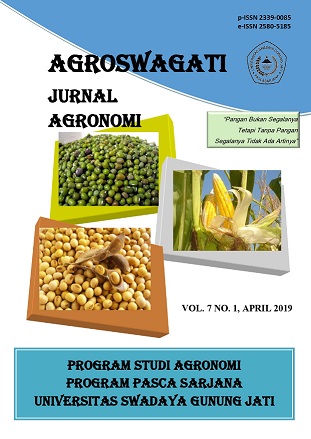PENGARUH PUPUK HAYATI CAIR DAN JARAK TANAM TERHADAP PERTUMBUHAN DAN HASIL TANAMAN KACANG TANAH ( Arachis hypogaea L. ) VARIETAS TALAM 1
DOI:
https://doi.org/10.33603/agroswagati.v7i1.2847Kata Kunci:
liquid biofertilizer, spacing, peanut, growth, resultsAbstrak
This study aimed to: (1) determine the effect of the interaction between liquid biofertilizer and plant spacing on growth and yield of peanut (Arachis hypogea L.) varieties Talam 1, (2) determine the concentration of liquid biofertilizer that gives effect the best on the growth and yield of peanut (Arachis hypogea L.) varieties Talam 1, and (3) determine the relationship between growth and yield components of peanut (Arachis hypogea L.) varieties Talam 1. The experiment was conducted from April until July 2018 at Sangkanurip Village, Cigandamekar District, Kuningan Regency. Located at a hight of 434,2 m above sea level.
The method used in this study is the experimental method. The experimental design used was a randomized block design (RBD) factorial. The study consisted of two treatment factors, is the dose of biofertilizer concentration and the plant spacing repeated three times. The first factor, namely the concentration liquid biofertilizer consists of four levels, namely: K1 (concentration 0 ml / 1 liter of water) K2 (concentration 5 ml / 1 liter of water) K3 (concentration 10 ml / 1 liter of water) K4 (concentration 15 ml / 1 liter of water). The second factor is a spacing (J) consists of three levels, namely: J1 (30 x 15 cm), J2 (30 x 20 cm), and J3 (30 x 25 cm).
The results showed that: (1) there is an interaction between liquid biofertilizer and plant spacing on plant height DAP age 41, fresh pods weight per hill, and the weight of dry pods per plot, (2) The treatment of concentration 10 ml / 1 liter of water (K3) and a spacing of 30 x 20 cm (J2) showed the best effect on the weight of dry pods each plot which produces 1.43 kg/plot, equivalent to the average yield of 2,33 tons / ha, with assuming  80% effective field, (3) there is a significant correlation between plant height age 31, 41 DAP, number of leaves age 21, 41 DAP, leaf area index, and root volume with the weight of dry pods for each  plot.Referensi
Adesemoye, A.O., Kloepper, J.W. “Plant-microbes interactions in enhanced fertilizer-use efficiencyâ€. Appl Microbiol Biotechnol. 85, 1-12. (2009).
Asroh, A. 2010. Pengaruh Takaran Pupuk Kandang dan Interval Pemberian Pupuk Hayati terhadap Pertumbuhan dan Hasil Tanaman Jagung Manis (Zea mays saccharata Linn). J. Agronomi. 2 (4): 144-148
Asyiardi, Nurnayetti. 1995. Pengaruh jarak barian tanam dan pemangkasan daun bawah tanaman jagung dalam tumpangsari dengan kacang tanah terhadap efisiensi radiasi surya dan produksi. Risalah Seminar Balittan Sukarami. 8:104-115.
Balai Penelitian Tanah 2016. Laporan Hasil Pengujian Pupuk Hayati Cair Biotipul. Balai Penelitian Tanah Bogor.
Balitkabi. 2012. Deskripsi Varietas Unggul Kacang-kacangan dan Umbi-umbian. Badan Litbang Pertanian.
Boote, K.J. 1982. Growth stages of peanut (Arachis hypogaea L.). Peanut Sci. 9:35–39.
Gardner, F.P.,R.B. Peace, dan R.L. Michell. 1991. Fisiologi Tanaman Budidaya. Terjemahan Herawati Susilo. Jakarta (ID) : UI Pres.
Gomez, KA & A.A Gomez, 1995. Statistical Procedures For Agricultural Research 2 Edition, Wiley. Pp. 100-104
Elfarisna dan Nosa, 2016. Respon Pertumbuhan dan Produksi Tanaman Bawang Merah (Allium ascalonicum L.) dengan Penambahan Pupuk Organik Cair. Fakultas Agroteknologi. UMJ
Fadiluddin, M. 2009. Efektivitas Formula Pupuk Hayati Dalam Memacu Serapan
Hara, Produksi dan Kualitas Hasil Jagung dan Padi Gogo di Lapang.
Institut Pertanian Bogor. Bogor. 69 hlm.
Hidayat, P. 2008. Pengaruh Dosis Kompos Pupuk Kandang Sapi Terhadap Pertumbuhan dan Produksi Buah Tomat (Skripsi S-1 Jurusan BudidayaPertanian Fakultas Pertanian Universitas Lampung.
Harjadi, S. M., 2002. Pengantar Agronomi. Gramedia Pustaka Utama, Jakarta
Harjoko, D. 2005. Hubungan antar dosis pemupukan nitrogen, kadar klorofil dan laju fotosintesis pada tanaman padi sawah..
Haryanto, B. 2007. Sukses bertanam Jagung Komoditas Pertanian yang menjanjikan, Pustka Baru Press. Yogyakarta
Juliarina. 2002. Ilmu Kesuburan Tanah Kanisius. Yogyakarta.
Mugnisah, W.Q dan A. Setiawan 1990. Pengantar Produksi Benih. Edisi 1. Rajawali. Persada Jakarta.
Murinnie, E.D. 2007. Analisis Pertumbuhan Kacang Tanah dan Pergeseran Komposisi Gulma pada Frekuensi Penyiangan dan Jarak Tanam Yang Berbeda. Laporan Penelitian. Staf Pengajar Fakultas Pertanian Universitas Muria Kudus.
Nurmala dan Irawan, 2007. Budidaya Tanaman Kacang-Kacangan. PT Karya Nusantara, Jakarta.
Rao, NSS. (1994). “Mikroorganisme Tanah dan Pertumbuhan Tanaman†. Jakarta : Universitas Indonesia Press (1994).
Soedjono. 2006. Kacang-kacangan. PT Remaja Rosdakarya. Bandung. 47 hal.
Soepardi, G. 1986. Sifat dan Ciri Tanah. Ilmu Tanah Faklutas Pertanian IPB,. Bogor
Sutanto, R. 2002. Pertanian Organik Kanisius: Yogyakarta.
Suprapto, 2004. Bertanam kacang tanah. Penebar Swadaya. Jakarta.
Sutrisno. 2004. Studi Dosis Pupuk dan Jarak Tanam Kacang Tanah (Arachis hypogaea, L.). Pati (ID): Kantor Litbang Kabupaten Pati.
Suwarsono, 2011. Pengaruh Beberapa Jenis Pupuk Kandang terhadap Pertumbuhan dan Produksi Kacang Tanah. UPBJJ – UT. Yogyakarta.
Unduhan
Diterbitkan
Terbitan
Bagian
Lisensi
The Authors submitting a manuscript do so on the understanding that if accepted for publication, copyright of the article shall be assigned to Jurnal AGROSWAGATI, Sekolah Pascasarjana Ilmu Pertanian. Universitas Swadaya Gunung Jati as publisher of the journal. Copyright encompasses rights to reproduce and deliver the article in all form and media, including reprints, photographs, microfilms, and any other similar reproductions, as well as translations.
Jurnal AGROSWAGATI, Universitas Swadaya Gunung Jati and the Editors make every effort to ensure that no wrong or misleading data, opinions or statements be published in the journal. In any way, the contents of the articles and advertisements published in Jurnal AGROSWAGATIare the sole responsibility of their respective authors and advertisers.

